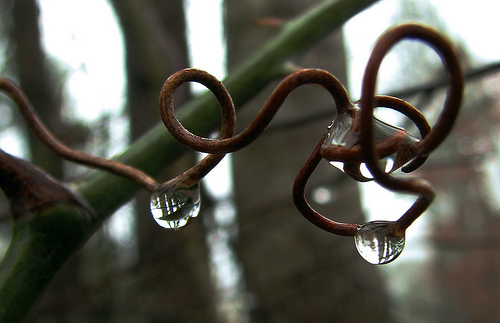FWP:
SETS == IDIOMS
What exactly is the relationship among 'weeping', and 'the opening of the knot of the heart', and the lover's condition? Nazm thinks that 'the opening of the knot of the heart' simply means weeping unrestrainedly. Bekhud Mohani thinks that weeping leads to the 'opening of the heart', and that this process erases sorrow. Faruqi points out both that a flow of tears forms a kind of string, and that when a knot in string has been wetted, it contracts and becomes tighter, and is thus harder to open.
The verse makes a clever double use of the imagery of 'to open'. For the common idiom dil khol kar ronaa , to weep without restraint, or literally 'to weep having opened the heart', can't help but come to mind in the context of the verse; the commentators invoke it quite explicitly, and it's hard to read the verse without thinking of it. Yet the verb kholnaa doesn't appear at all in the verse, since it's replaced by its Persianized counterpart vaa karnaa . Ghalib surely meant to evoke the idiom, without establishing its presence in any straightforward way.
For what it means to 'open the heart' remains ambiguous. It's actually 'the knot of the heart' that might or might not be opened, and the 'opening' or untying of a knot is a different image from the 'opening' of the heart through weeping-- or through a wound, as in {209,4}. Moreover, thanks to the versatility of the i.zaafat , the knot of the heart needn't be the heart itself: it might be a knot created by the heart, or somehow pertaining or belonging to the heart.
If we look at the other 'knot' verses, the 'knot' seems either
to consist of the absence of the heart (in {8,2}),
or almost of the heart itself (in {48,3});
but neither verse gives us any association with weeping. So in an additional
reading (2b), the weeping in the present verse might be merely a helpless reaction
to an intractable problem: the speaker's plea is, 'After all, I'm desperate--
sometime, somehow, let somebody open the knot of the heart!' Since this hasn't
happened, and shows no sign of happening, his friend should be compassionate
and shouldn't reproach him for weeping with the pain of his tormented, convoluted,
knotted-up heart. Maybe the weeping would even attract the attention of people
(like the beloved?) who might help him to open it.

Nazm:
In this verse se is a translation from Persian; with regard to the idiom of Urdu, this is a place for par . By the 'opening of the knot of the heart' is meant weeping without restraint [dil khol kar ronaa]. (242)
== Nazm page 242